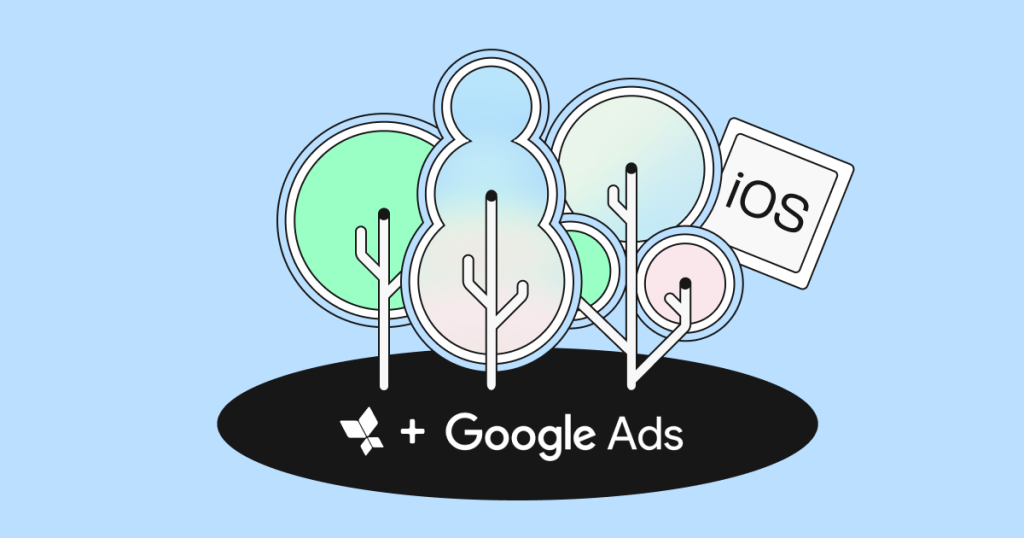What every marketer needs to know about streaming ads


We’ve all been there. You’re watching a video on your favorite streaming platform and an ad pops up. But, this ad is a bit different from a traditional TV ad. It’s tailored specifically for your interests. It may even feature an app that you were just researching.
Welcome to the world of streaming ads. With nearly 5 billion people predicted to be consuming OTT content by 2029, this is a huge market with massive potential for advertising.
If you’re an app marketer, understanding streaming ads isn’t a luxury, it’s a must. In this blog, we’ll take a look at everything you need to know about streaming ads and how to make them work for your campaigns.
What are streaming ads?
Streaming ads are digital advertisements that appear while a user watches or listens to streaming content. This includes TV shows, movies, and any other video or audio content delivered over the internet.
What makes these ads so unique is that unlike traditional TV commercials, streaming ads can be dynamically inserted and personalized based on viewer data. This makes them more relevant and engaging.
Streaming ads are an evolution of traditional TV advertising with the precision targeting and measurement capabilities of digital marketing. When a user streams content on a platform such as Hulu, Spotify, or YouTube, these ads are a seamless part of their viewing experience.
The real power of streaming ads lies in their ability to combine the impact of television’s sight, sound, and motion with the precision of digital targeting. For app marketers, this means you can showcase your app’s features in a rich, engaging format while ensuring your ad reaches users most likely to convert.
Streaming ads vs. OTT and CTV
Before we dive deeper into the world of streaming ads, let’s take a look at a few related terms. Marketers often talk about streaming ads, OTT, and CTV together — or mix the terms up — because they all involve delivering content over the internet. However, as we explain below, these terms refer to slightly different things.
OTT (Over-the-top)
OTT refers to any content delivered via the internet, bypassing traditional cable or satellite providers. While streaming ads are a part of OTT advertising, OTT is a broader term encompassing all forms of internet-delivered content and advertising.
For example, when users stream Netflix on their phones or watch YouTube videos on their laptops, they’re consuming OTT content. The key distinction is that OTT includes all streaming services, whether they’re ad-supported or not.
CTV (Connected TV)
CTV is the device used to stream content. This includes smart TVs, streaming devices like Roku and Apple TV, and gaming consoles. The terms “CTV ads” and “streaming ads” are often used interchangeably, because the ads appear on your streaming device.
What are the different types of streaming ads?
The streaming ad ecosystem offers different formats to help marketers achieve their goals. Let’s explore each type in detail:
Pre-roll ads
Pre-roll ads play before your content begins — a format you’ll recognize from YouTube. They’re effective because viewers are fresh and engaged, waiting for their content to start. For example, a fitness app might show its ad before workout videos. For app marketers, this is a prime opportunity to showcase your app’s value proposition before viewers become immersed in their content.
Post-roll ads
Post-roll ads appear after content has ended. These ads can be particularly effective for calls-to-action, since viewers have just finished engaging with content. They’re perfect for app install campaigns when viewers are deciding what to do next.
While post-roll ads typically see lower completion rates than pre-roll, the viewers who do watch them tend to be more engaged and likely to take action. Consider using these slots for direct response campaigns with strong CTAs.
Pause ads
These ads appear when viewers pause their content, making the most of what would otherwise be dead space. Think of a food delivery app showing its ad when someone pauses their favorite cooking show. These ads are particularly effective because they appear during natural breaks in viewing behavior.
Shoppable ads
Shoppable ads are interactive and allow viewers to make purchases directly through their TV or device. Think about watching a gaming stream and being able to download the advertised mobile game instantly. For app marketers, this means viewers can install your app directly from their TV, using their mobile device as a companion screen.
Product placement
Product placement refers to the natural integration of products or services within the content itself. This could be a character using a specific app or service during a show. Modern streaming platforms can dynamically insert different product placements for different viewers, making this traditionally rigid format more flexible and targetable.
Overlay ads
These ads appear as semi-transparent overlays during content playback, similar to YouTube’s lower-third ads. They’re less intrusive while maintaining visibility. Overlay ads are effective for mobile app campaigns because they can be designed to complement rather than interrupt the viewing experience.
Interactive ads
These are ads that viewers can engage with using their remote or device, making them perfect for app marketers looking to drive immediate action.
Interactive ads can include features like:
- QR codes for instant app downloads
- Voice commands for smart TV interactions
- Mini-games or demos
- Poll questions
- Choose-your-own-adventure style narratives
Video streaming revenue models
AVOD (Advertising-based video on demand)
AVOD platforms, like YouTube, are free to use but include ads. It’s those ads that bring in revenue for the platform.
TVOD (Transactional video on demand)
TVOD platforms charge a one-time fee to watch content. This can be a pay-per-view model (often used for sports games), an electronic sell-through (EST) model where users pay once for unlimited access to a specific piece of content, or a download-to-rent (DTR) model, commonly used for renting movies for 24 or 48 hours. Google TV is an example of a TVOD platform.
SVOD (Subscription video on demand)
SVOD gives subscribers unlimited access to content for a subscription fee. This is typically a monthly or annual payment. Popular platforms include Netflix, Disney+, and Prime Video.
Benefits of streaming ads
Streaming ads offer several advantages that make them particularly attractive for app marketers.
Efficient targeting
Streaming platforms collect rich first-party data, including viewing preferences and habits, device usage patterns, household composition, geographic location, and content genre preferences. For app marketers, this means you can reach specific audiences and target users who are most likely to download and engage with your app.
Increased engagement
With better targeting comes higher engagement rates. This increased attention translates to higher ad recall rates, better message retention, increased likelihood of taking action, and stronger brand association.
Dynamic ad insertion (DAI)
Streaming ads give marketers more flexibility than traditional TV ad slots. For example, you can update creative assets in real time based on performance, adjust messaging, perform A/B testing, and optimize delivery based on viewer reception and responses.
For app marketers, this means you can quickly iterate on your creative and messaging to find what drives the best install rates.
Cost effectiveness
Compared to traditional TV advertising, streaming ads often provide better ROI. This is because marketers can reduce waste through precise targeting, lower minimum spending requirements, and more flexible buying options. Many platforms offer entry-level packages starting at a few thousand dollars, making it accessible for apps of all sizes to test the waters.
Personalized marketing messages
Streaming ads allow marketers to create personalized messages based on viewer preferences and behavior. This could include highlighting different app features for different audiences, localizing messaging and offers, and including device-specific prompts.
Increased viewership and global reach
With streaming ads, marketers can reach viewers worldwide. This is a huge benefit compared with traditional methods of advertising, where you would have to buy ad space in each geographic market. Marketers can deploy language-specific creatives, target by region, city, or ZIP code, and adjust messaging for cultural contexts.
Real-time analytics
Perhaps the most important advantage of streaming ads is the ability to see real-time analytics. By analyzing numbers in real time, marketers can adjust campaigns to perform better. This includes looking at completion rates, click-through rates, engagement metrics like cost per completed view, and return on ad spend (ROAS).
Full funnel retargeting
Streaming ads aren’t just a “one and done” — you can connect with viewers throughout their customer journey, with ads tailored to the various buying stages of awareness, consideration, conversion, and retention.
How to set up streaming ads
To get started with streaming ads, follow these steps:
- Define your target audience. Create detailed audience personas based on demographics, viewing habits, device usage, app usage patterns, and purchase behavior.
- Choose your platform and create your ad. Check the creative specifications for your chosen platform (they do vary) and create your ad in line with these.
- Set your budget and bidding strategy. Work out how much you can afford to spend on this campaign and over what time period. You can tweak your campaign strategy as you go along to make sure you’re allocating resources effectively.
- Leverage data for targeting. Use a combination of first-party data, platform data, and third-party data to be sure you’re reaching your ideal audience.
- Place your ad. This includes technical implementation such as creating an account on the appropriate platform, setting up billing, and installing pixels. Then you need to set up the campaign, which includes defining objectives, uploading assets, setting frequency caps, and enabling safety settings.
- Measure results and optimize. Continuously track key metrics to optimize your campaign in real time.
Best practices for streaming ads
There’s no need to reinvent the wheel when it comes to streaming ads. Here are some best practices:
- Identify your target audience in advance. Don’t just launch and hope for the best. Deep audience research is necessary to create the right personas, understand viewing behavior, and map audience segments to different streaming services.
- Optimize your creative for the platform. Not all platforms are created equal. Optimize both the technical aspects and the content of your campaign to get the most from each platform.
- Perform A/B tests. Test different parts of your campaign systematically. This may include opening sequences, CTA placement, music and sound effects, voice-over styles, ad lengths, and more. You can also look at the time of day, device types, and geographic regions to learn what’s most effective.
- Use advanced analytics. Basic metrics will give you basic information about the success of your campaign. Dive deeper by looking at completion rates by platform, attribution windows, incremental reach, and cost per completed view.
- Optimize for mobile. This may sound obvious, but it’s essential to get it right. Don’t forget that many users often switch between devices, so all campaigns should include a cross-device strategy.
- Maintain brand consistency. Aim to create a recognizable visual style with consistent messaging, so that users can immediately identify your brand.
- Prioritize ad timing. Use strategic timing to create maximum impact. This includes analyzing viewing patterns by day and time, accounting for seasonal factors, matching ad tone to content mood, and testing pre-, mid-, and post-roll placements.
- Use voiceovers and captions where appropriate. Use clear, professional voice talent with a voice that matches the target demographic. This includes accents and emotional tones. For captions, use easy-to-read fonts, remain synchronized, and maintain proper contrast.
- Analyze and optimize. As with every campaign, keep analyzing and optimizing as you go. Make a list of weekly and monthly tasks including analyzing performance, reviewing audience responses, and adjusting strategy.
The future for streaming ads
What does the future of streaming ads look like? Let’s take a look at a few trends:
- Hyper personalization. Moving forward, AI and ML (machine learning) technology will help us adapt ads in real time based on viewer behavior, preferences, and context.
- Interactive ads. The future may see less passive ad-watching and more active engagement. This is already beginning with QR codes and voice commands, but the next generation of interactive ads will create completely immersive experiences.
- AI-powered creatives. AI will not only play an important role in optimizing ad delivery but also transform the creative process itself. AI will be able to analyze viewer responses to adjust elements of ads in real-time, creating an optimal experience for viewers.
- Privacy measures. With all of the excitement of AI and hyper-personalization, privacy measures will remain an important topic in the streaming ad space. Marketers will have to look for privacy-centric platforms and spaces to remain compliant.
- Programmatic ad placement. This field will continue to evolve, becoming more efficient and sophisticated. This includes AI making real-time decisions about ad placements.
Key takeaways
- Streaming ads are digital advertisements that appear while users stream content over the internet, offering the visual impact of TV commercials combined with precise digital targeting capabilities.
- The streaming ad ecosystem includes multiple formats, including pre-roll ads, post-roll ads, pause ads, shoppable ads, product placement, overlay ads, and interactive ads.
- There are three main revenue models in video streaming: AVOD (ad-supported free content like YouTube), TVOD (pay-per-view content like Google TV), and SVOD (subscription-based services like Netflix).
- Key benefits of streaming ads include efficient targeting using viewer data, increased engagement rates, dynamic ad insertion capabilities, cost-effectiveness, personalization options, global reach, and real-time analytics.
- Setting up streaming ads starts with defining target audiences and choosing platforms, then creating appropriate ad content. You need to set a budget and study targeting data before implementing your campaign and continuously measuring results.
- The future of streaming ads points toward hyper-personalization through AI/ML technology, more interactive ad experiences, AI-powered creative content, enhanced privacy measures, and sophisticated programmatic ad placement.










